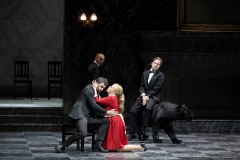The Treasure Hunter
Mo | Tu | We | Th | Fr | Sa | Su |
The Treasure Hunter (Der Schatzgräber)
Franz Schreker [1878 – 1934]
An opera in four acts, with a prologue and an epilogue, by Franz Schreker with a libretto by the composer.
First performed on 21 January 1920 at the Oper Frankfurt
Premiered at the Deutsche Oper Berlin on 1 May 2022
approx. 3 hrs 15 mins / 1 interval
In German with German and English surtitles
Pre-performance lecture (in German): 45 minutes prior to each performance
About the performance
Director Christof Loy has already helped four little-known operas from the early 20th century make a successful comeback at the Deutsche Oper Berlin: Erich Wolfgang Korngold's DAS WUNDER DER HELIANE and Riccardo Zandonai's FRANCESCA DA RIMINI were followed by other long-forgotten operatic treasures: Franz Schreker's DER SCHATZGRÄBER in 2022 and finally Ottorino Respighi's LA FIAMMA in 2024.
DER SCHATZGRÄBER was one of the most important operas of the 1920s. The work was a triumph at its world premiere in Frankfurt in 1920 and went on to play 44 times at assorted venues over the next five years. It then fell victim to a shifting zeitgeist and slipped from opera-house programmes, with a National Socialist ban on performances sealing its demise. Even after 1945 the Schreker revival was a long time coming – and THE TREASURE HUNTER has not featured prominently in the renaissance.
As with the vast majority of Schreker’s libretti, the story of Els and Elis explores the relationship between fantasy and reality, between art and life. Soulmates in the sense that they are both at the mercy of the king’s disposition, Els and Elis set off in search of different treasures. Elis, the minstrel, uses his magic lute to locate a stash of jewels and do humanity a good turn. Els, an innkeeper’s daughter who has grown up motherless in a tough, male-chauvinist world, becomes a liar, cheat and murderess in pursuit of her goal, tasking her suitors to steal the queen’s jewels and then having them killed once they have returned with the haul of treasure. Yet even with the gold in their possession, the pair are not content, and so, true to form, Schreker turns his attention to the theme of yearning per se, which is the actual “treasure” that the composer is interested in, “a dream of happiness and redemption”. Elis and Els are caught up in a swirl of dreams, memories, premonitions, songs and music. Their stories take on a dreamlike quality in a world beset by greed, murder and emotional inconstancy. For Franz Schreker the path to redemption could only be via art. Composed during the turmoil of the First World War, the TREASURE HUNTER score amounts to Schreker’s personal confession of artistic faith, executed in florid strokes of late-Romantic musical colour.
Synopsis
The opera is set in legendary medieval times.
Act 1
Els, daughter of the innkeeper, has to marry a brutal but rich young nobleman she despises. She therefore sends him away to find the queen's jewels, and has him murdered by Albi, her servant, who is in love with her. The minstrel Elis has meanwhile found his way to the inn and presents Els with an ornament he has found in the woods. Els falls in love with the young minstrel, but then the body of the dead nobleman is found in the woods; the bailiff, who wants Els for himself, arrests Elis on suspicion of murder.
Act 2
Elis is to be hanged for his crime. Els asks the fool for help, who assures her that all will turn out well. The king's messenger stops the execution at the last moment, so Elis can go in search of the jewels. To avoid being exposed as the thief, Els orders Albi to steal the minstrel's magic lute.
Act 3
During a night of love, Els presents herself to Elis in the full beauty of the jewels. She hands over the jewellery to him, on condition that he will never ask her about their provenance, and will always trust her.
Act 4
Elis has returned the jewels to the queen. During a celebration, the bailiff intervenes and announces that Albi has confessed to the murder. Els is denounced as the instigator of the murder, and the bailiff demands her immediate execution. But the fool, reminding the king of his promise, chooses Els as his wife and thus saves her from being executed. They go off together.
Program and cast
Conductor: Marc Albrecht
Stage direction: Christof Loy
Set design: Johannes Leiacker
Costume design: Barbara Drosihn
Light design: Olaf Winter
Chorus Director: Jeremy Bines
Dramaturge: Dorothea Hartmann
The King: Jared Werlein
The Queen: Doke Pauwels
The chancellor: Clemens Bieber
The Count / A Herald: Philipp Jekal
The schoolmaster / The mayor: Joel Allison
The fool: Thomas Cilluffo
The bailiff: Thomas Johannes Mayer
The young nobleman: Byung Gil Kim
Elis: Daniel Johansson
The scribe: Michael Dimovski
The innkeeper: Volodymyr Morozov
Els: Elisabet Strid
Albi: Patrick Cook
Land servant: Paul Minhyung Roh
Chorus, solo parts: Asahi Wada
Chorus, solo parts: N. N.
Chorus, solo parts: N. N.
Actors: Michael Gernot Sumper
Actors: Tobias Wollschläger
Actors: Eric Naumann
Actors: Stefan Liebermann
Actors: Hanno Jusek
Actors: Nicolas Franciscus
Actors: Koray Tuna
Actors: Niall Fallon
Actors: Benjamin Werth
Actors: Jeanna Serikbayeva
Actors: Eva Paulina Loska
Actors: Xenia Wolfgramm
Chorus: Chor der Deutschen Oper Berlin
Orchestra: Orchester der Deutschen Oper Berlin
Deutsche Oper Berlin
The Deutsche Oper Berlin is an opera company located in the Charlottenburg district of Berlin, Germany. The resident building is the country's second largest opera house and also home to the Berlin State Ballet.
The company's history goes back to the Deutsches Opernhaus built by the then independent city of Charlottenburg—the "richest town of Prussia"—according to plans designed by Heinrich Seeling from 1911. It opened on November 7, 1912 with a performance of Beethoven's Fidelio, conducted by Ignatz Waghalter. After the incorporation of Charlottenburg by the 1920 Greater Berlin Act, the name of the resident building was changed to Städtische Oper (Municipal Opera) in 1925.
Deutsches Opernhaus, 1912
With the Nazi Machtergreifung in 1933, the opera was under control of the Reich Ministry of Public Enlightenment and Propaganda. Minister Joseph Goebbels had the name changed back to Deutsches Opernhaus, competing with the Berlin State Opera in Mitte controlled by his rival, the Prussian minister-president Hermann Göring. In 1935, the building was remodeled by Paul Baumgarten and the seating reduced from 2300 to 2098. Carl Ebert, the pre-World War II general manager, chose to emigrate from Germany rather than endorse the Nazi view of music, and went on to co-found the Glyndebourne opera festival in England. He was replaced by Max von Schillings, who acceded to enact works of "unalloyed German character". Several artists, like the conductor Fritz Stiedry or the singer Alexander Kipnis followed Ebert into emigration. The opera house was destroyed by a RAF air raid on 23 November 1943. Performances continued at the Admiralspalast in Mitte until 1945. Ebert returned as general manager after the war.
After the war, the company in what was now West Berlin used the nearby building of the Theater des Westens until the opera house was rebuilt. The sober design by Fritz Bornemann was completed on 24 September 1961. The opening production was Mozart's Don Giovanni. The new building opened with the current name.

 EN
EN DE
DE IT
IT FR
FR ES
ES RU
RU JP
JP RO
RO
 Seating plan
Seating plan 


